Report on Understanding and Leading Change: NATS and National Railway
VerifiedAdded on 2023/01/07
|13
|3987
|39
Report
AI Summary
This report examines the multifaceted aspects of organizational change, using NATS and National Railway as case studies. It explores the impact of change on organizational strategy and operations, differentiating between strategic, structural, process-based, and people-centric changes. The report delves into how drivers of change affect leadership behavior, team dynamics, and individual performance, highlighting the need for leaders to adapt and motivate employees. It further analyzes methods for minimizing the negative impacts of change, particularly focusing on Kotter's change management theory and its eight-step process. The report emphasizes the importance of communication, vision, and removing obstacles to ensure successful change implementation. Through this analysis, the report provides a comprehensive understanding of change management principles and their practical application within the context of the aviation and railway industries.
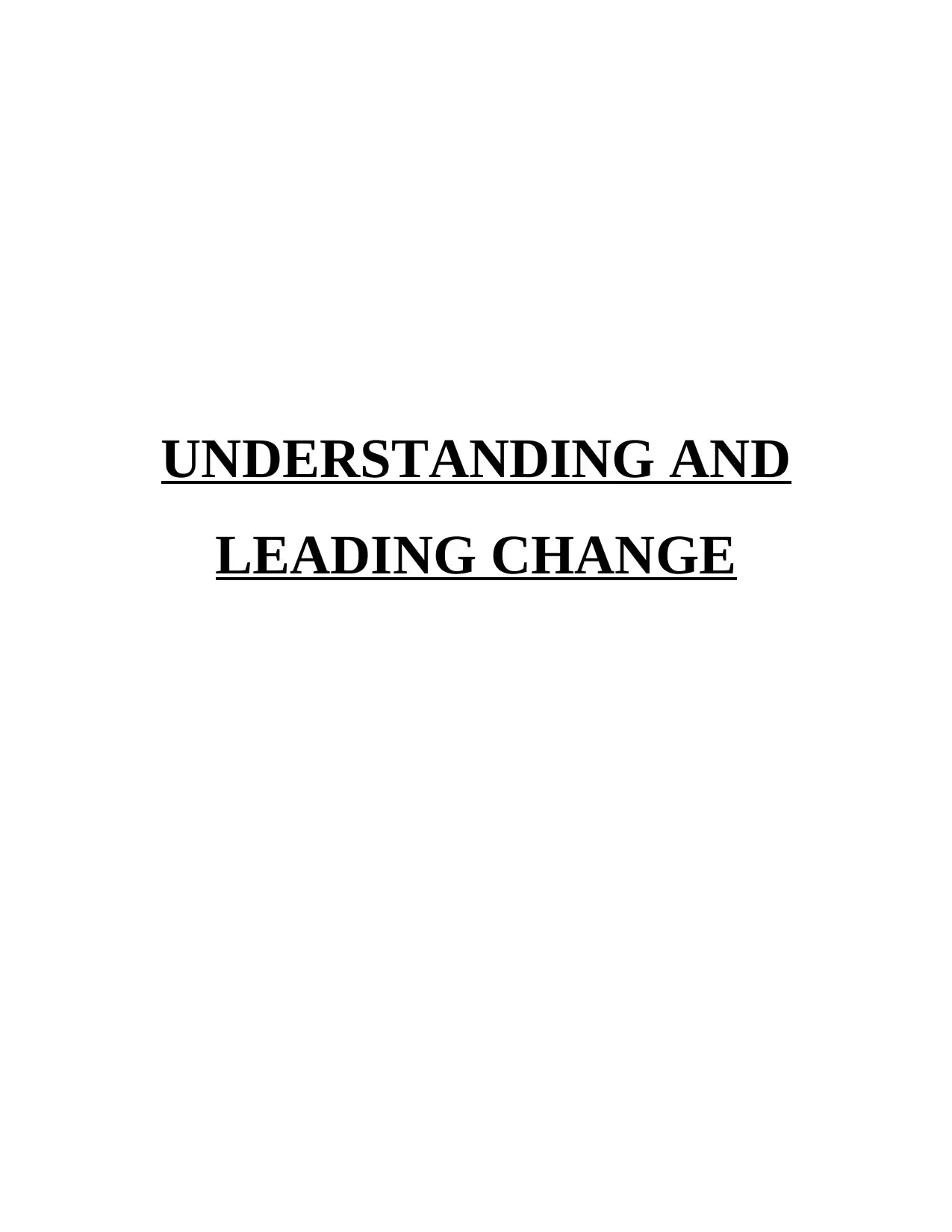
UNDERSTANDING AND
LEADING CHANGE
LEADING CHANGE
Paraphrase This Document
Need a fresh take? Get an instant paraphrase of this document with our AI Paraphraser
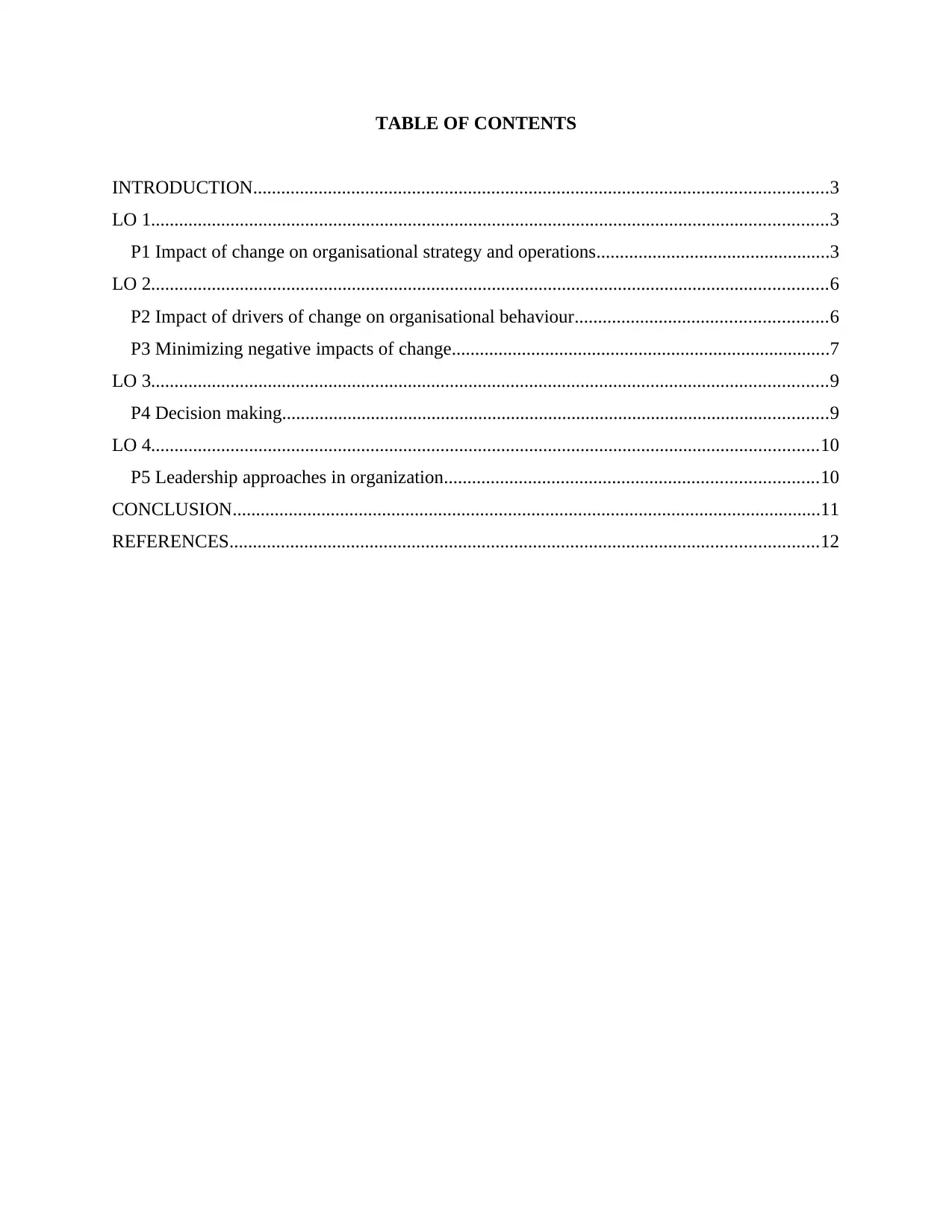
TABLE OF CONTENTS
INTRODUCTION...........................................................................................................................3
LO 1.................................................................................................................................................3
P1 Impact of change on organisational strategy and operations..................................................3
LO 2.................................................................................................................................................6
P2 Impact of drivers of change on organisational behaviour......................................................6
P3 Minimizing negative impacts of change.................................................................................7
LO 3.................................................................................................................................................9
P4 Decision making.....................................................................................................................9
LO 4...............................................................................................................................................10
P5 Leadership approaches in organization................................................................................10
CONCLUSION..............................................................................................................................11
REFERENCES..............................................................................................................................12
INTRODUCTION...........................................................................................................................3
LO 1.................................................................................................................................................3
P1 Impact of change on organisational strategy and operations..................................................3
LO 2.................................................................................................................................................6
P2 Impact of drivers of change on organisational behaviour......................................................6
P3 Minimizing negative impacts of change.................................................................................7
LO 3.................................................................................................................................................9
P4 Decision making.....................................................................................................................9
LO 4...............................................................................................................................................10
P5 Leadership approaches in organization................................................................................10
CONCLUSION..............................................................................................................................11
REFERENCES..............................................................................................................................12
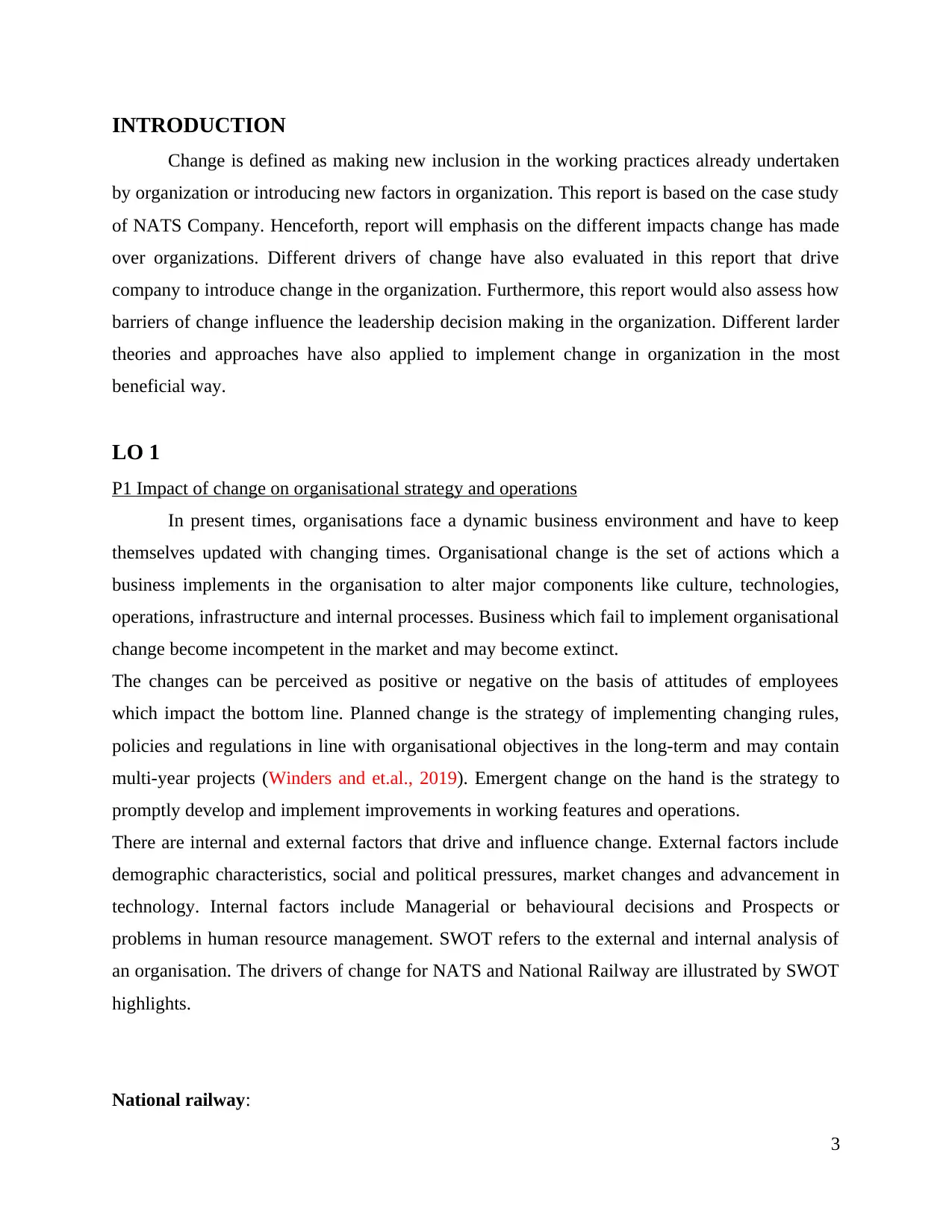
INTRODUCTION
Change is defined as making new inclusion in the working practices already undertaken
by organization or introducing new factors in organization. This report is based on the case study
of NATS Company. Henceforth, report will emphasis on the different impacts change has made
over organizations. Different drivers of change have also evaluated in this report that drive
company to introduce change in the organization. Furthermore, this report would also assess how
barriers of change influence the leadership decision making in the organization. Different larder
theories and approaches have also applied to implement change in organization in the most
beneficial way.
LO 1
P1 Impact of change on organisational strategy and operations
In present times, organisations face a dynamic business environment and have to keep
themselves updated with changing times. Organisational change is the set of actions which a
business implements in the organisation to alter major components like culture, technologies,
operations, infrastructure and internal processes. Business which fail to implement organisational
change become incompetent in the market and may become extinct.
The changes can be perceived as positive or negative on the basis of attitudes of employees
which impact the bottom line. Planned change is the strategy of implementing changing rules,
policies and regulations in line with organisational objectives in the long-term and may contain
multi-year projects (Winders and et.al., 2019). Emergent change on the hand is the strategy to
promptly develop and implement improvements in working features and operations.
There are internal and external factors that drive and influence change. External factors include
demographic characteristics, social and political pressures, market changes and advancement in
technology. Internal factors include Managerial or behavioural decisions and Prospects or
problems in human resource management. SWOT refers to the external and internal analysis of
an organisation. The drivers of change for NATS and National Railway are illustrated by SWOT
highlights.
National railway:
3
Change is defined as making new inclusion in the working practices already undertaken
by organization or introducing new factors in organization. This report is based on the case study
of NATS Company. Henceforth, report will emphasis on the different impacts change has made
over organizations. Different drivers of change have also evaluated in this report that drive
company to introduce change in the organization. Furthermore, this report would also assess how
barriers of change influence the leadership decision making in the organization. Different larder
theories and approaches have also applied to implement change in organization in the most
beneficial way.
LO 1
P1 Impact of change on organisational strategy and operations
In present times, organisations face a dynamic business environment and have to keep
themselves updated with changing times. Organisational change is the set of actions which a
business implements in the organisation to alter major components like culture, technologies,
operations, infrastructure and internal processes. Business which fail to implement organisational
change become incompetent in the market and may become extinct.
The changes can be perceived as positive or negative on the basis of attitudes of employees
which impact the bottom line. Planned change is the strategy of implementing changing rules,
policies and regulations in line with organisational objectives in the long-term and may contain
multi-year projects (Winders and et.al., 2019). Emergent change on the hand is the strategy to
promptly develop and implement improvements in working features and operations.
There are internal and external factors that drive and influence change. External factors include
demographic characteristics, social and political pressures, market changes and advancement in
technology. Internal factors include Managerial or behavioural decisions and Prospects or
problems in human resource management. SWOT refers to the external and internal analysis of
an organisation. The drivers of change for NATS and National Railway are illustrated by SWOT
highlights.
National railway:
3
⊘ This is a preview!⊘
Do you want full access?
Subscribe today to unlock all pages.

Trusted by 1+ million students worldwide
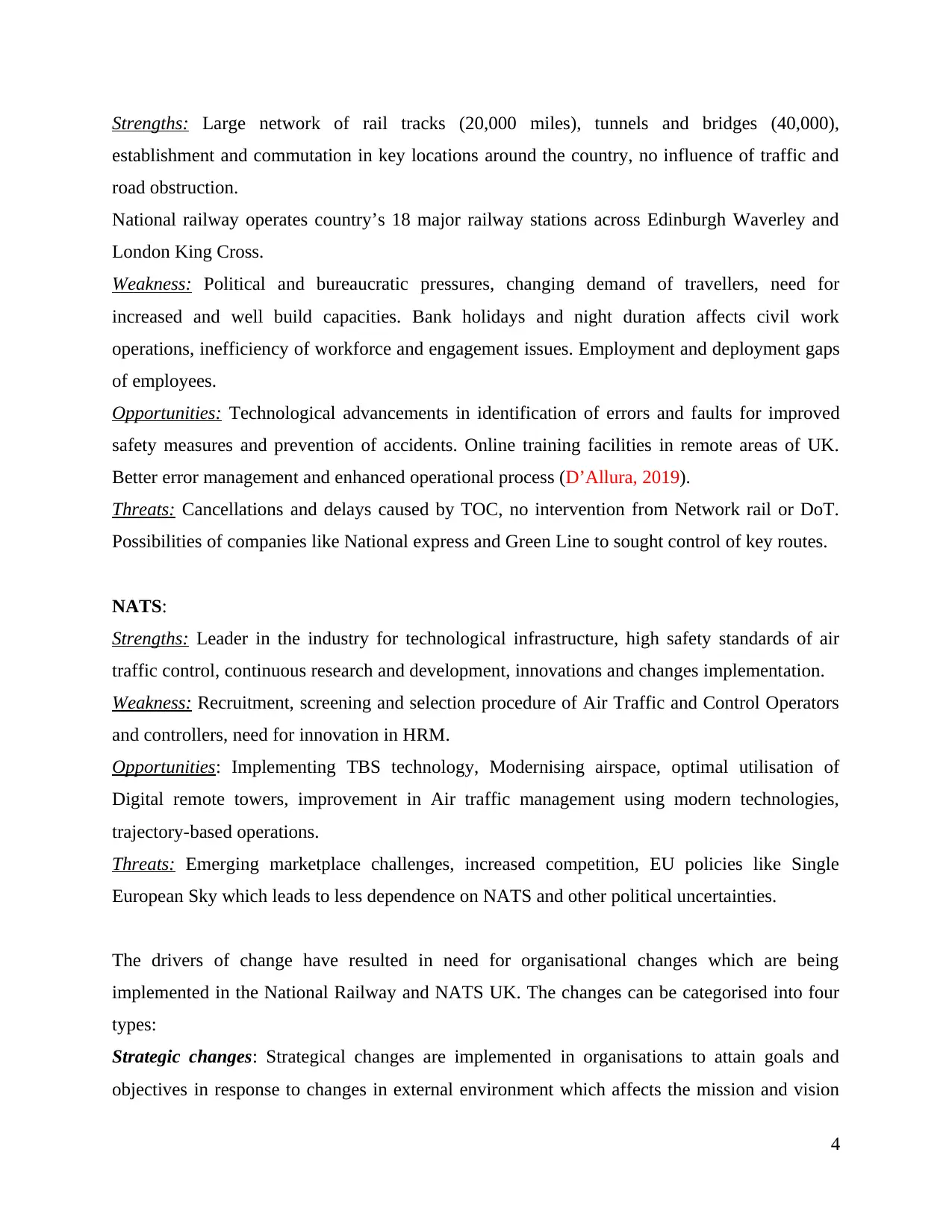
Strengths: Large network of rail tracks (20,000 miles), tunnels and bridges (40,000),
establishment and commutation in key locations around the country, no influence of traffic and
road obstruction.
National railway operates country’s 18 major railway stations across Edinburgh Waverley and
London King Cross.
Weakness: Political and bureaucratic pressures, changing demand of travellers, need for
increased and well build capacities. Bank holidays and night duration affects civil work
operations, inefficiency of workforce and engagement issues. Employment and deployment gaps
of employees.
Opportunities: Technological advancements in identification of errors and faults for improved
safety measures and prevention of accidents. Online training facilities in remote areas of UK.
Better error management and enhanced operational process (D’Allura, 2019).
Threats: Cancellations and delays caused by TOC, no intervention from Network rail or DoT.
Possibilities of companies like National express and Green Line to sought control of key routes.
NATS:
Strengths: Leader in the industry for technological infrastructure, high safety standards of air
traffic control, continuous research and development, innovations and changes implementation.
Weakness: Recruitment, screening and selection procedure of Air Traffic and Control Operators
and controllers, need for innovation in HRM.
Opportunities: Implementing TBS technology, Modernising airspace, optimal utilisation of
Digital remote towers, improvement in Air traffic management using modern technologies,
trajectory-based operations.
Threats: Emerging marketplace challenges, increased competition, EU policies like Single
European Sky which leads to less dependence on NATS and other political uncertainties.
The drivers of change have resulted in need for organisational changes which are being
implemented in the National Railway and NATS UK. The changes can be categorised into four
types:
Strategic changes: Strategical changes are implemented in organisations to attain goals and
objectives in response to changes in external environment which affects the mission and vision
4
establishment and commutation in key locations around the country, no influence of traffic and
road obstruction.
National railway operates country’s 18 major railway stations across Edinburgh Waverley and
London King Cross.
Weakness: Political and bureaucratic pressures, changing demand of travellers, need for
increased and well build capacities. Bank holidays and night duration affects civil work
operations, inefficiency of workforce and engagement issues. Employment and deployment gaps
of employees.
Opportunities: Technological advancements in identification of errors and faults for improved
safety measures and prevention of accidents. Online training facilities in remote areas of UK.
Better error management and enhanced operational process (D’Allura, 2019).
Threats: Cancellations and delays caused by TOC, no intervention from Network rail or DoT.
Possibilities of companies like National express and Green Line to sought control of key routes.
NATS:
Strengths: Leader in the industry for technological infrastructure, high safety standards of air
traffic control, continuous research and development, innovations and changes implementation.
Weakness: Recruitment, screening and selection procedure of Air Traffic and Control Operators
and controllers, need for innovation in HRM.
Opportunities: Implementing TBS technology, Modernising airspace, optimal utilisation of
Digital remote towers, improvement in Air traffic management using modern technologies,
trajectory-based operations.
Threats: Emerging marketplace challenges, increased competition, EU policies like Single
European Sky which leads to less dependence on NATS and other political uncertainties.
The drivers of change have resulted in need for organisational changes which are being
implemented in the National Railway and NATS UK. The changes can be categorised into four
types:
Strategic changes: Strategical changes are implemented in organisations to attain goals and
objectives in response to changes in external environment which affects the mission and vision
4
Paraphrase This Document
Need a fresh take? Get an instant paraphrase of this document with our AI Paraphraser
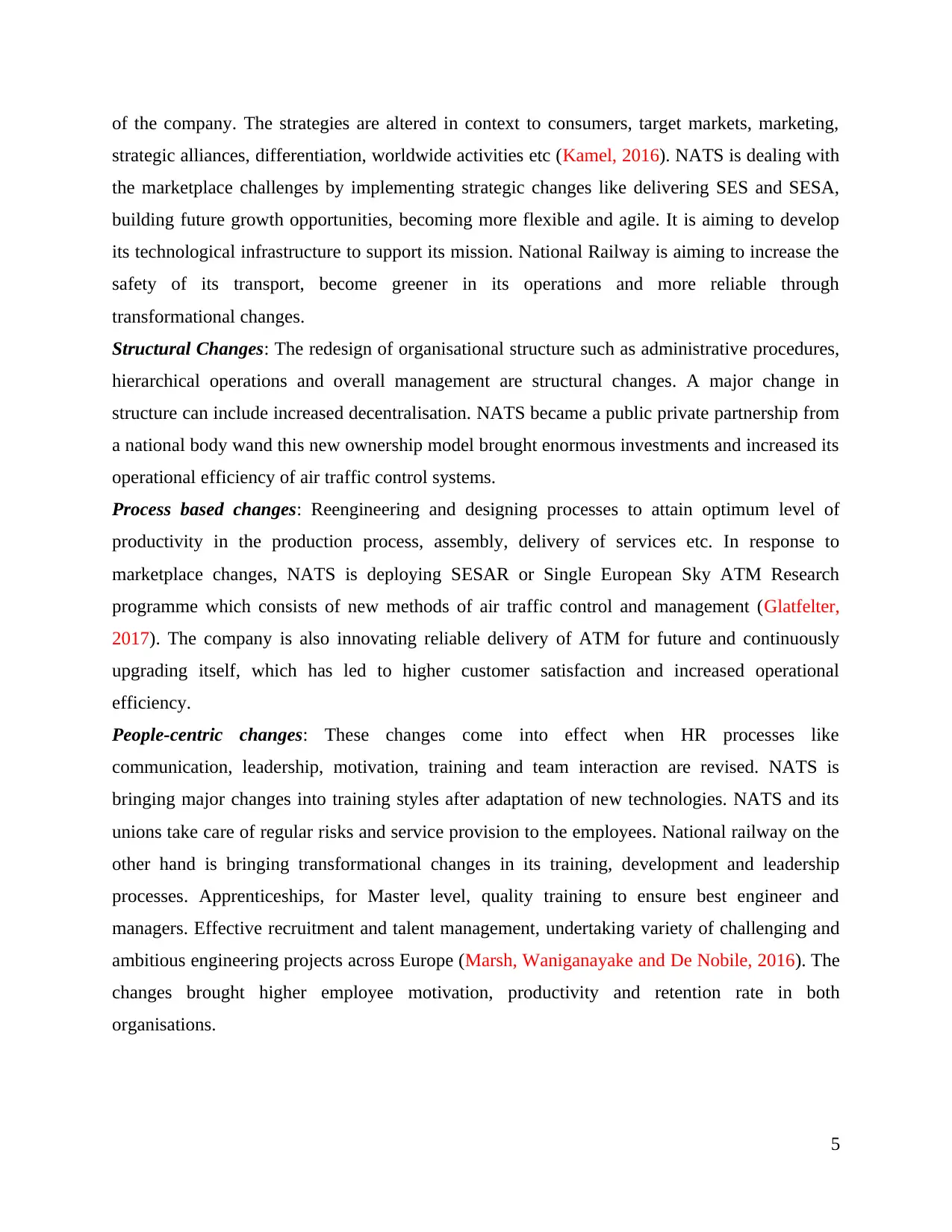
of the company. The strategies are altered in context to consumers, target markets, marketing,
strategic alliances, differentiation, worldwide activities etc (Kamel, 2016). NATS is dealing with
the marketplace challenges by implementing strategic changes like delivering SES and SESA,
building future growth opportunities, becoming more flexible and agile. It is aiming to develop
its technological infrastructure to support its mission. National Railway is aiming to increase the
safety of its transport, become greener in its operations and more reliable through
transformational changes.
Structural Changes: The redesign of organisational structure such as administrative procedures,
hierarchical operations and overall management are structural changes. A major change in
structure can include increased decentralisation. NATS became a public private partnership from
a national body wand this new ownership model brought enormous investments and increased its
operational efficiency of air traffic control systems.
Process based changes: Reengineering and designing processes to attain optimum level of
productivity in the production process, assembly, delivery of services etc. In response to
marketplace changes, NATS is deploying SESAR or Single European Sky ATM Research
programme which consists of new methods of air traffic control and management (Glatfelter,
2017). The company is also innovating reliable delivery of ATM for future and continuously
upgrading itself, which has led to higher customer satisfaction and increased operational
efficiency.
People-centric changes: These changes come into effect when HR processes like
communication, leadership, motivation, training and team interaction are revised. NATS is
bringing major changes into training styles after adaptation of new technologies. NATS and its
unions take care of regular risks and service provision to the employees. National railway on the
other hand is bringing transformational changes in its training, development and leadership
processes. Apprenticeships, for Master level, quality training to ensure best engineer and
managers. Effective recruitment and talent management, undertaking variety of challenging and
ambitious engineering projects across Europe (Marsh, Waniganayake and De Nobile, 2016). The
changes brought higher employee motivation, productivity and retention rate in both
organisations.
5
strategic alliances, differentiation, worldwide activities etc (Kamel, 2016). NATS is dealing with
the marketplace challenges by implementing strategic changes like delivering SES and SESA,
building future growth opportunities, becoming more flexible and agile. It is aiming to develop
its technological infrastructure to support its mission. National Railway is aiming to increase the
safety of its transport, become greener in its operations and more reliable through
transformational changes.
Structural Changes: The redesign of organisational structure such as administrative procedures,
hierarchical operations and overall management are structural changes. A major change in
structure can include increased decentralisation. NATS became a public private partnership from
a national body wand this new ownership model brought enormous investments and increased its
operational efficiency of air traffic control systems.
Process based changes: Reengineering and designing processes to attain optimum level of
productivity in the production process, assembly, delivery of services etc. In response to
marketplace changes, NATS is deploying SESAR or Single European Sky ATM Research
programme which consists of new methods of air traffic control and management (Glatfelter,
2017). The company is also innovating reliable delivery of ATM for future and continuously
upgrading itself, which has led to higher customer satisfaction and increased operational
efficiency.
People-centric changes: These changes come into effect when HR processes like
communication, leadership, motivation, training and team interaction are revised. NATS is
bringing major changes into training styles after adaptation of new technologies. NATS and its
unions take care of regular risks and service provision to the employees. National railway on the
other hand is bringing transformational changes in its training, development and leadership
processes. Apprenticeships, for Master level, quality training to ensure best engineer and
managers. Effective recruitment and talent management, undertaking variety of challenging and
ambitious engineering projects across Europe (Marsh, Waniganayake and De Nobile, 2016). The
changes brought higher employee motivation, productivity and retention rate in both
organisations.
5
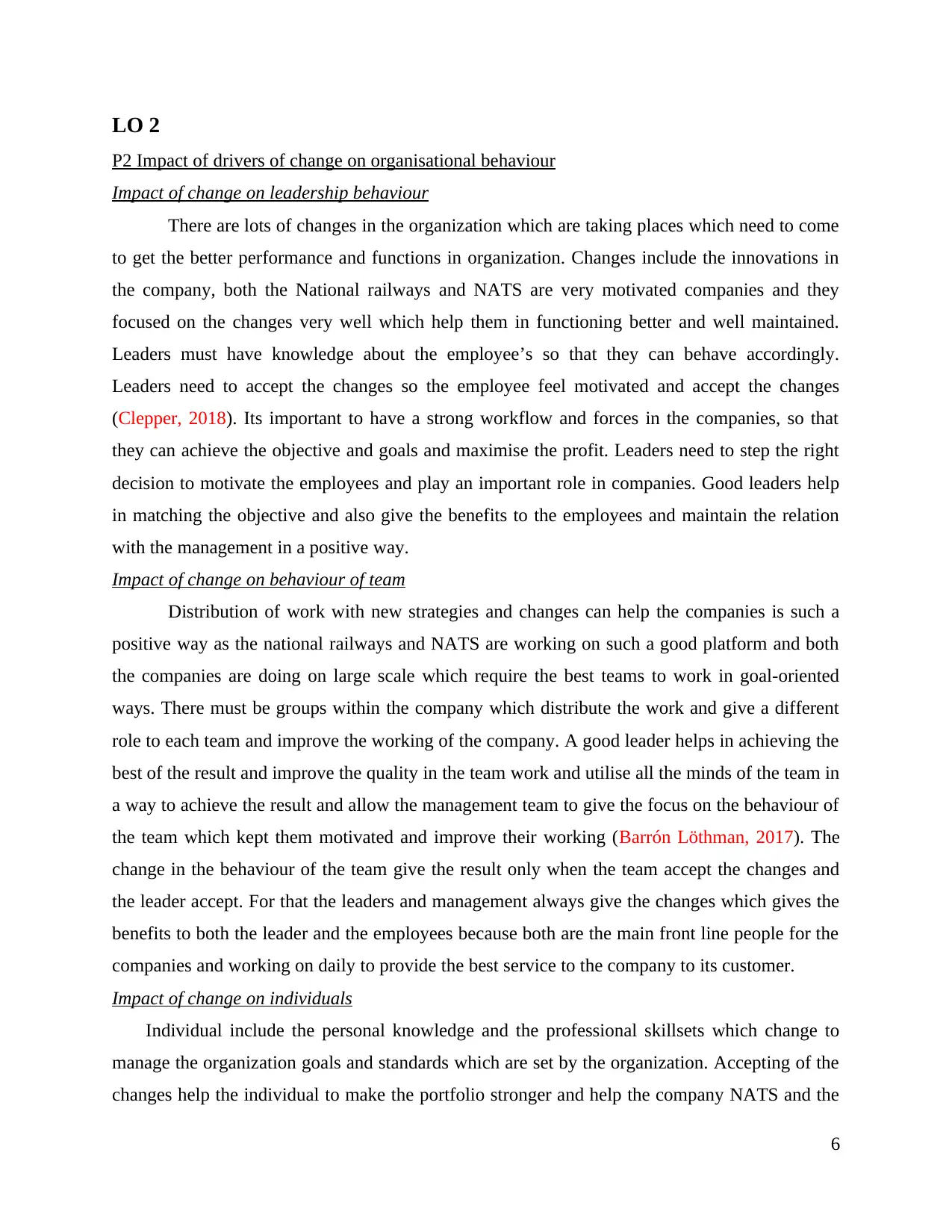
LO 2
P2 Impact of drivers of change on organisational behaviour
Impact of change on leadership behaviour
There are lots of changes in the organization which are taking places which need to come
to get the better performance and functions in organization. Changes include the innovations in
the company, both the National railways and NATS are very motivated companies and they
focused on the changes very well which help them in functioning better and well maintained.
Leaders must have knowledge about the employee’s so that they can behave accordingly.
Leaders need to accept the changes so the employee feel motivated and accept the changes
(Clepper, 2018). Its important to have a strong workflow and forces in the companies, so that
they can achieve the objective and goals and maximise the profit. Leaders need to step the right
decision to motivate the employees and play an important role in companies. Good leaders help
in matching the objective and also give the benefits to the employees and maintain the relation
with the management in a positive way.
Impact of change on behaviour of team
Distribution of work with new strategies and changes can help the companies is such a
positive way as the national railways and NATS are working on such a good platform and both
the companies are doing on large scale which require the best teams to work in goal-oriented
ways. There must be groups within the company which distribute the work and give a different
role to each team and improve the working of the company. A good leader helps in achieving the
best of the result and improve the quality in the team work and utilise all the minds of the team in
a way to achieve the result and allow the management team to give the focus on the behaviour of
the team which kept them motivated and improve their working (Barrón Löthman, 2017). The
change in the behaviour of the team give the result only when the team accept the changes and
the leader accept. For that the leaders and management always give the changes which gives the
benefits to both the leader and the employees because both are the main front line people for the
companies and working on daily to provide the best service to the company to its customer.
Impact of change on individuals
Individual include the personal knowledge and the professional skillsets which change to
manage the organization goals and standards which are set by the organization. Accepting of the
changes help the individual to make the portfolio stronger and help the company NATS and the
6
P2 Impact of drivers of change on organisational behaviour
Impact of change on leadership behaviour
There are lots of changes in the organization which are taking places which need to come
to get the better performance and functions in organization. Changes include the innovations in
the company, both the National railways and NATS are very motivated companies and they
focused on the changes very well which help them in functioning better and well maintained.
Leaders must have knowledge about the employee’s so that they can behave accordingly.
Leaders need to accept the changes so the employee feel motivated and accept the changes
(Clepper, 2018). Its important to have a strong workflow and forces in the companies, so that
they can achieve the objective and goals and maximise the profit. Leaders need to step the right
decision to motivate the employees and play an important role in companies. Good leaders help
in matching the objective and also give the benefits to the employees and maintain the relation
with the management in a positive way.
Impact of change on behaviour of team
Distribution of work with new strategies and changes can help the companies is such a
positive way as the national railways and NATS are working on such a good platform and both
the companies are doing on large scale which require the best teams to work in goal-oriented
ways. There must be groups within the company which distribute the work and give a different
role to each team and improve the working of the company. A good leader helps in achieving the
best of the result and improve the quality in the team work and utilise all the minds of the team in
a way to achieve the result and allow the management team to give the focus on the behaviour of
the team which kept them motivated and improve their working (Barrón Löthman, 2017). The
change in the behaviour of the team give the result only when the team accept the changes and
the leader accept. For that the leaders and management always give the changes which gives the
benefits to both the leader and the employees because both are the main front line people for the
companies and working on daily to provide the best service to the company to its customer.
Impact of change on individuals
Individual include the personal knowledge and the professional skillsets which change to
manage the organization goals and standards which are set by the organization. Accepting of the
changes help the individual to make the portfolio stronger and help the company NATS and the
6
⊘ This is a preview!⊘
Do you want full access?
Subscribe today to unlock all pages.

Trusted by 1+ million students worldwide
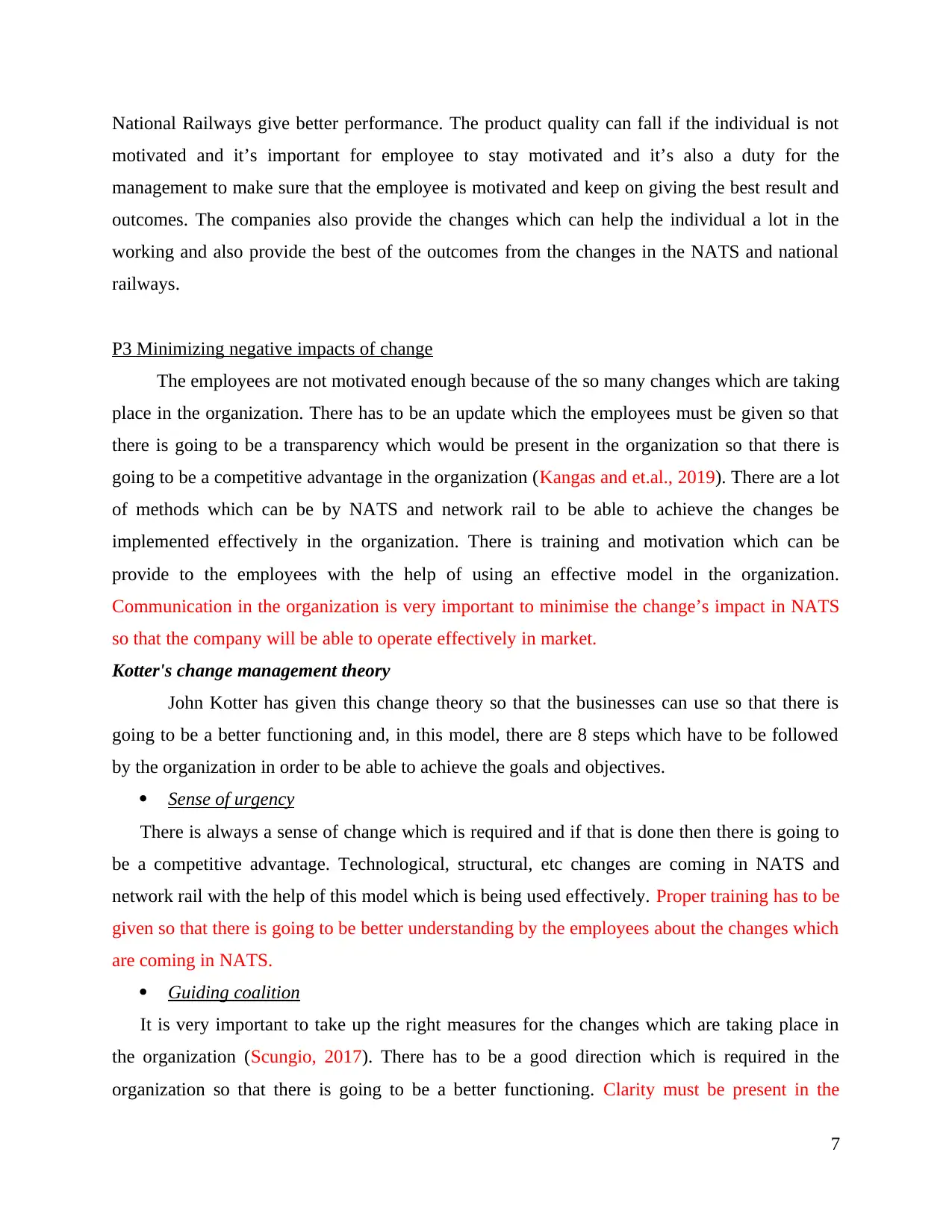
National Railways give better performance. The product quality can fall if the individual is not
motivated and it’s important for employee to stay motivated and it’s also a duty for the
management to make sure that the employee is motivated and keep on giving the best result and
outcomes. The companies also provide the changes which can help the individual a lot in the
working and also provide the best of the outcomes from the changes in the NATS and national
railways.
P3 Minimizing negative impacts of change
The employees are not motivated enough because of the so many changes which are taking
place in the organization. There has to be an update which the employees must be given so that
there is going to be a transparency which would be present in the organization so that there is
going to be a competitive advantage in the organization (Kangas and et.al., 2019). There are a lot
of methods which can be by NATS and network rail to be able to achieve the changes be
implemented effectively in the organization. There is training and motivation which can be
provide to the employees with the help of using an effective model in the organization.
Communication in the organization is very important to minimise the change’s impact in NATS
so that the company will be able to operate effectively in market.
Kotter's change management theory
John Kotter has given this change theory so that the businesses can use so that there is
going to be a better functioning and, in this model, there are 8 steps which have to be followed
by the organization in order to be able to achieve the goals and objectives.
Sense of urgency
There is always a sense of change which is required and if that is done then there is going to
be a competitive advantage. Technological, structural, etc changes are coming in NATS and
network rail with the help of this model which is being used effectively. Proper training has to be
given so that there is going to be better understanding by the employees about the changes which
are coming in NATS.
Guiding coalition
It is very important to take up the right measures for the changes which are taking place in
the organization (Scungio, 2017). There has to be a good direction which is required in the
organization so that there is going to be a better functioning. Clarity must be present in the
7
motivated and it’s important for employee to stay motivated and it’s also a duty for the
management to make sure that the employee is motivated and keep on giving the best result and
outcomes. The companies also provide the changes which can help the individual a lot in the
working and also provide the best of the outcomes from the changes in the NATS and national
railways.
P3 Minimizing negative impacts of change
The employees are not motivated enough because of the so many changes which are taking
place in the organization. There has to be an update which the employees must be given so that
there is going to be a transparency which would be present in the organization so that there is
going to be a competitive advantage in the organization (Kangas and et.al., 2019). There are a lot
of methods which can be by NATS and network rail to be able to achieve the changes be
implemented effectively in the organization. There is training and motivation which can be
provide to the employees with the help of using an effective model in the organization.
Communication in the organization is very important to minimise the change’s impact in NATS
so that the company will be able to operate effectively in market.
Kotter's change management theory
John Kotter has given this change theory so that the businesses can use so that there is
going to be a better functioning and, in this model, there are 8 steps which have to be followed
by the organization in order to be able to achieve the goals and objectives.
Sense of urgency
There is always a sense of change which is required and if that is done then there is going to
be a competitive advantage. Technological, structural, etc changes are coming in NATS and
network rail with the help of this model which is being used effectively. Proper training has to be
given so that there is going to be better understanding by the employees about the changes which
are coming in NATS.
Guiding coalition
It is very important to take up the right measures for the changes which are taking place in
the organization (Scungio, 2017). There has to be a good direction which is required in the
organization so that there is going to be a better functioning. Clarity must be present in the
7
Paraphrase This Document
Need a fresh take? Get an instant paraphrase of this document with our AI Paraphraser
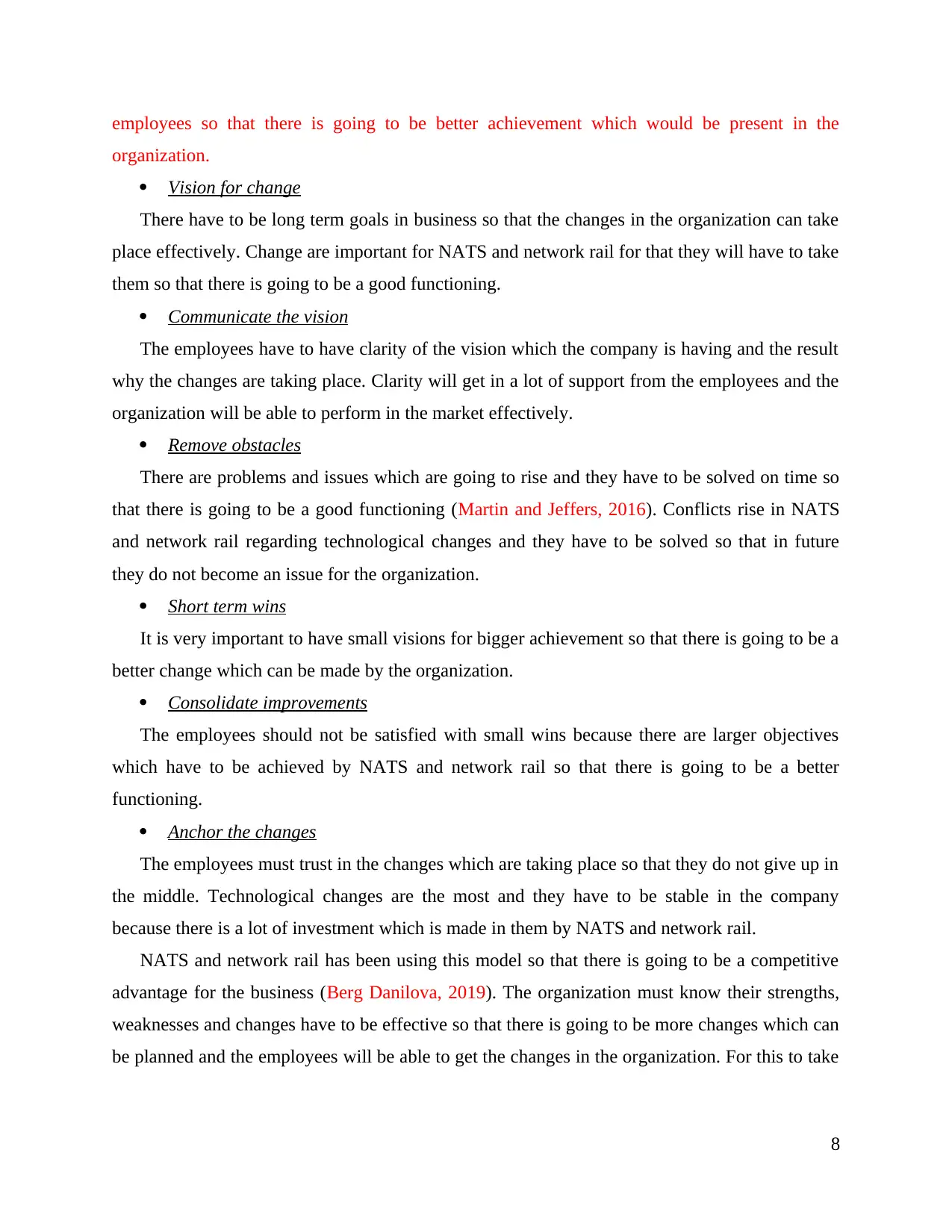
employees so that there is going to be better achievement which would be present in the
organization.
Vision for change
There have to be long term goals in business so that the changes in the organization can take
place effectively. Change are important for NATS and network rail for that they will have to take
them so that there is going to be a good functioning.
Communicate the vision
The employees have to have clarity of the vision which the company is having and the result
why the changes are taking place. Clarity will get in a lot of support from the employees and the
organization will be able to perform in the market effectively.
Remove obstacles
There are problems and issues which are going to rise and they have to be solved on time so
that there is going to be a good functioning (Martin and Jeffers, 2016). Conflicts rise in NATS
and network rail regarding technological changes and they have to be solved so that in future
they do not become an issue for the organization.
Short term wins
It is very important to have small visions for bigger achievement so that there is going to be a
better change which can be made by the organization.
Consolidate improvements
The employees should not be satisfied with small wins because there are larger objectives
which have to be achieved by NATS and network rail so that there is going to be a better
functioning.
Anchor the changes
The employees must trust in the changes which are taking place so that they do not give up in
the middle. Technological changes are the most and they have to be stable in the company
because there is a lot of investment which is made in them by NATS and network rail.
NATS and network rail has been using this model so that there is going to be a competitive
advantage for the business (Berg Danilova, 2019). The organization must know their strengths,
weaknesses and changes have to be effective so that there is going to be more changes which can
be planned and the employees will be able to get the changes in the organization. For this to take
8
organization.
Vision for change
There have to be long term goals in business so that the changes in the organization can take
place effectively. Change are important for NATS and network rail for that they will have to take
them so that there is going to be a good functioning.
Communicate the vision
The employees have to have clarity of the vision which the company is having and the result
why the changes are taking place. Clarity will get in a lot of support from the employees and the
organization will be able to perform in the market effectively.
Remove obstacles
There are problems and issues which are going to rise and they have to be solved on time so
that there is going to be a good functioning (Martin and Jeffers, 2016). Conflicts rise in NATS
and network rail regarding technological changes and they have to be solved so that in future
they do not become an issue for the organization.
Short term wins
It is very important to have small visions for bigger achievement so that there is going to be a
better change which can be made by the organization.
Consolidate improvements
The employees should not be satisfied with small wins because there are larger objectives
which have to be achieved by NATS and network rail so that there is going to be a better
functioning.
Anchor the changes
The employees must trust in the changes which are taking place so that they do not give up in
the middle. Technological changes are the most and they have to be stable in the company
because there is a lot of investment which is made in them by NATS and network rail.
NATS and network rail has been using this model so that there is going to be a competitive
advantage for the business (Berg Danilova, 2019). The organization must know their strengths,
weaknesses and changes have to be effective so that there is going to be more changes which can
be planned and the employees will be able to get the changes in the organization. For this to take
8
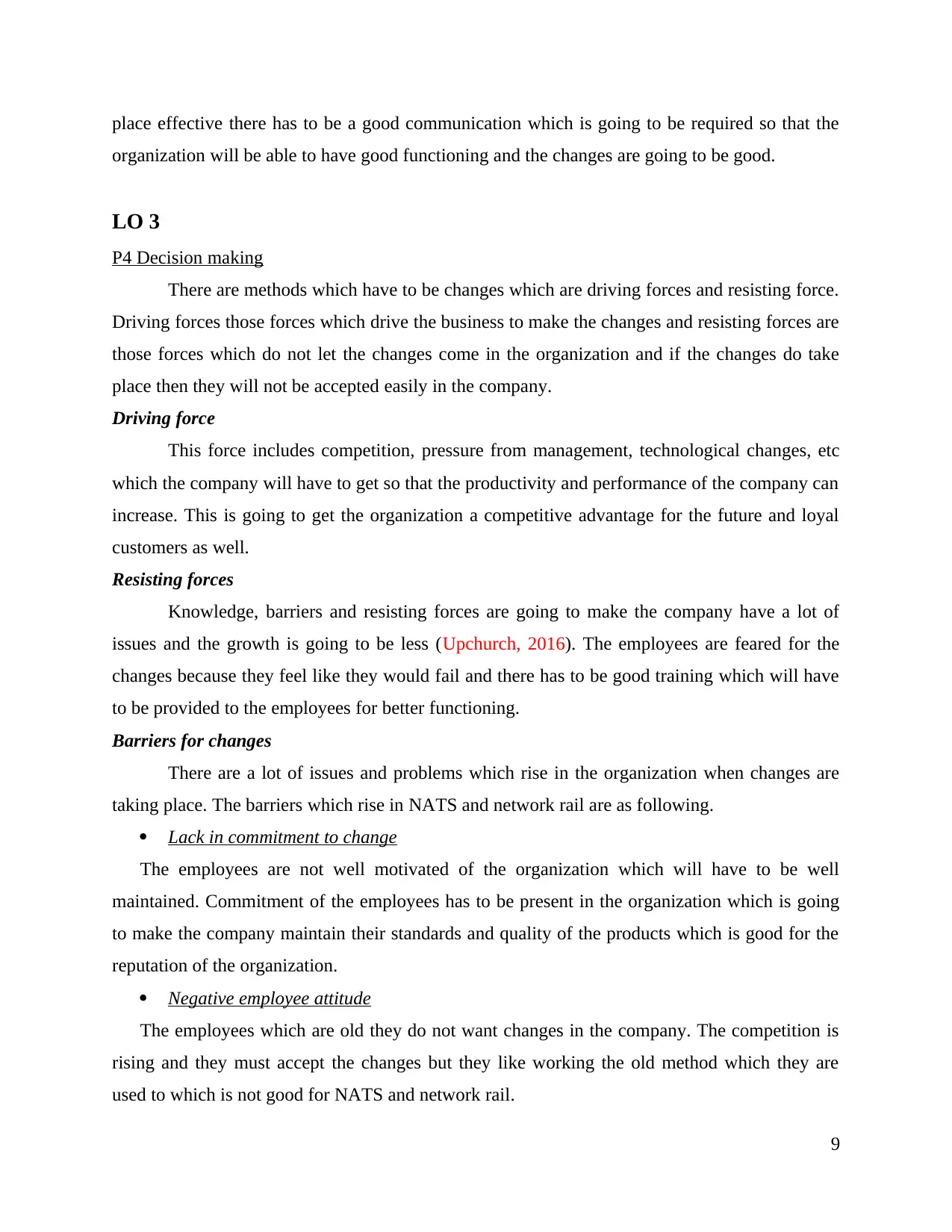
place effective there has to be a good communication which is going to be required so that the
organization will be able to have good functioning and the changes are going to be good.
LO 3
P4 Decision making
There are methods which have to be changes which are driving forces and resisting force.
Driving forces those forces which drive the business to make the changes and resisting forces are
those forces which do not let the changes come in the organization and if the changes do take
place then they will not be accepted easily in the company.
Driving force
This force includes competition, pressure from management, technological changes, etc
which the company will have to get so that the productivity and performance of the company can
increase. This is going to get the organization a competitive advantage for the future and loyal
customers as well.
Resisting forces
Knowledge, barriers and resisting forces are going to make the company have a lot of
issues and the growth is going to be less (Upchurch, 2016). The employees are feared for the
changes because they feel like they would fail and there has to be good training which will have
to be provided to the employees for better functioning.
Barriers for changes
There are a lot of issues and problems which rise in the organization when changes are
taking place. The barriers which rise in NATS and network rail are as following.
Lack in commitment to change
The employees are not well motivated of the organization which will have to be well
maintained. Commitment of the employees has to be present in the organization which is going
to make the company maintain their standards and quality of the products which is good for the
reputation of the organization.
Negative employee attitude
The employees which are old they do not want changes in the company. The competition is
rising and they must accept the changes but they like working the old method which they are
used to which is not good for NATS and network rail.
9
organization will be able to have good functioning and the changes are going to be good.
LO 3
P4 Decision making
There are methods which have to be changes which are driving forces and resisting force.
Driving forces those forces which drive the business to make the changes and resisting forces are
those forces which do not let the changes come in the organization and if the changes do take
place then they will not be accepted easily in the company.
Driving force
This force includes competition, pressure from management, technological changes, etc
which the company will have to get so that the productivity and performance of the company can
increase. This is going to get the organization a competitive advantage for the future and loyal
customers as well.
Resisting forces
Knowledge, barriers and resisting forces are going to make the company have a lot of
issues and the growth is going to be less (Upchurch, 2016). The employees are feared for the
changes because they feel like they would fail and there has to be good training which will have
to be provided to the employees for better functioning.
Barriers for changes
There are a lot of issues and problems which rise in the organization when changes are
taking place. The barriers which rise in NATS and network rail are as following.
Lack in commitment to change
The employees are not well motivated of the organization which will have to be well
maintained. Commitment of the employees has to be present in the organization which is going
to make the company maintain their standards and quality of the products which is good for the
reputation of the organization.
Negative employee attitude
The employees which are old they do not want changes in the company. The competition is
rising and they must accept the changes but they like working the old method which they are
used to which is not good for NATS and network rail.
9
⊘ This is a preview!⊘
Do you want full access?
Subscribe today to unlock all pages.

Trusted by 1+ million students worldwide
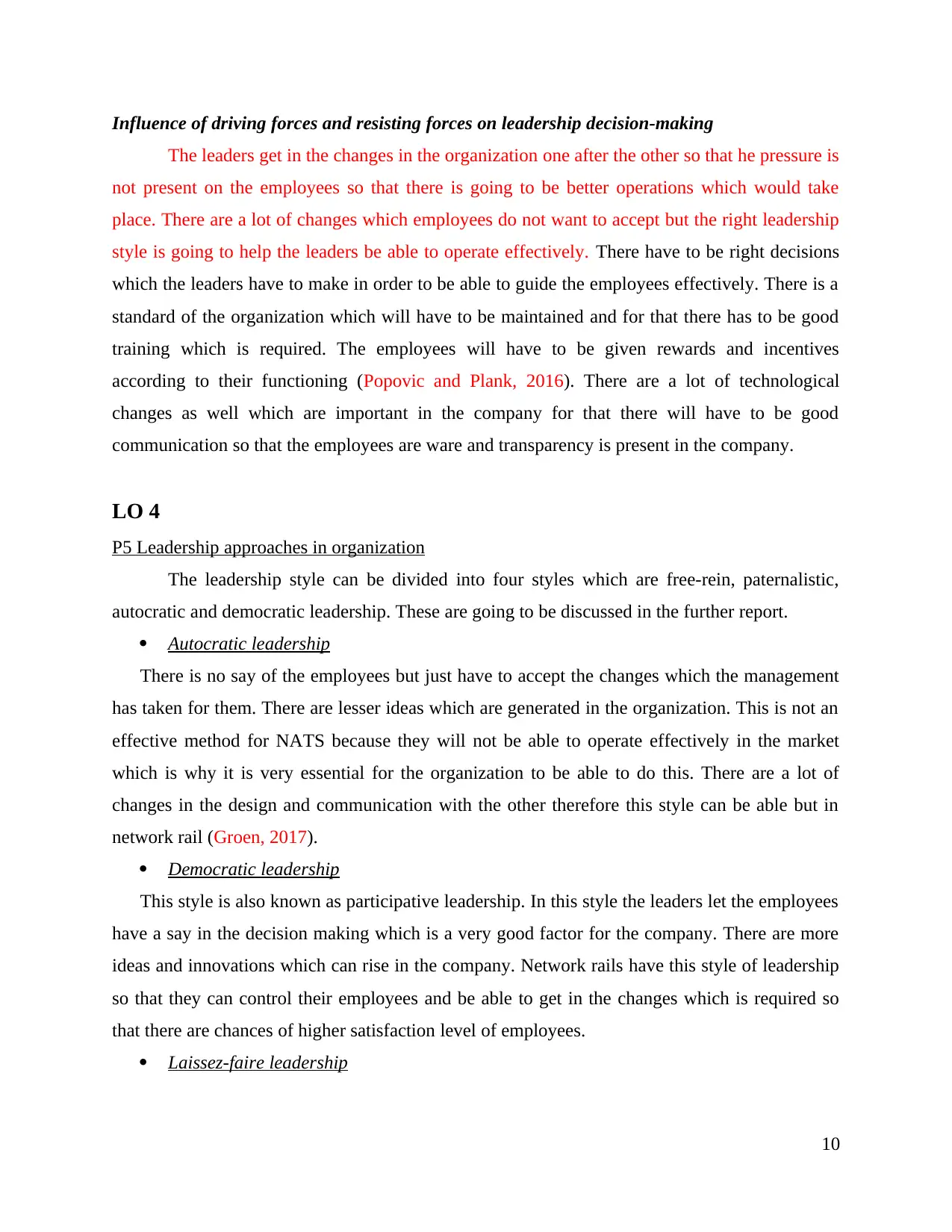
Influence of driving forces and resisting forces on leadership decision-making
The leaders get in the changes in the organization one after the other so that he pressure is
not present on the employees so that there is going to be better operations which would take
place. There are a lot of changes which employees do not want to accept but the right leadership
style is going to help the leaders be able to operate effectively. There have to be right decisions
which the leaders have to make in order to be able to guide the employees effectively. There is a
standard of the organization which will have to be maintained and for that there has to be good
training which is required. The employees will have to be given rewards and incentives
according to their functioning (Popovic and Plank, 2016). There are a lot of technological
changes as well which are important in the company for that there will have to be good
communication so that the employees are ware and transparency is present in the company.
LO 4
P5 Leadership approaches in organization
The leadership style can be divided into four styles which are free-rein, paternalistic,
autocratic and democratic leadership. These are going to be discussed in the further report.
Autocratic leadership
There is no say of the employees but just have to accept the changes which the management
has taken for them. There are lesser ideas which are generated in the organization. This is not an
effective method for NATS because they will not be able to operate effectively in the market
which is why it is very essential for the organization to be able to do this. There are a lot of
changes in the design and communication with the other therefore this style can be able but in
network rail (Groen, 2017).
Democratic leadership
This style is also known as participative leadership. In this style the leaders let the employees
have a say in the decision making which is a very good factor for the company. There are more
ideas and innovations which can rise in the company. Network rails have this style of leadership
so that they can control their employees and be able to get in the changes which is required so
that there are chances of higher satisfaction level of employees.
Laissez-faire leadership
10
The leaders get in the changes in the organization one after the other so that he pressure is
not present on the employees so that there is going to be better operations which would take
place. There are a lot of changes which employees do not want to accept but the right leadership
style is going to help the leaders be able to operate effectively. There have to be right decisions
which the leaders have to make in order to be able to guide the employees effectively. There is a
standard of the organization which will have to be maintained and for that there has to be good
training which is required. The employees will have to be given rewards and incentives
according to their functioning (Popovic and Plank, 2016). There are a lot of technological
changes as well which are important in the company for that there will have to be good
communication so that the employees are ware and transparency is present in the company.
LO 4
P5 Leadership approaches in organization
The leadership style can be divided into four styles which are free-rein, paternalistic,
autocratic and democratic leadership. These are going to be discussed in the further report.
Autocratic leadership
There is no say of the employees but just have to accept the changes which the management
has taken for them. There are lesser ideas which are generated in the organization. This is not an
effective method for NATS because they will not be able to operate effectively in the market
which is why it is very essential for the organization to be able to do this. There are a lot of
changes in the design and communication with the other therefore this style can be able but in
network rail (Groen, 2017).
Democratic leadership
This style is also known as participative leadership. In this style the leaders let the employees
have a say in the decision making which is a very good factor for the company. There are more
ideas and innovations which can rise in the company. Network rails have this style of leadership
so that they can control their employees and be able to get in the changes which is required so
that there are chances of higher satisfaction level of employees.
Laissez-faire leadership
10
Paraphrase This Document
Need a fresh take? Get an instant paraphrase of this document with our AI Paraphraser
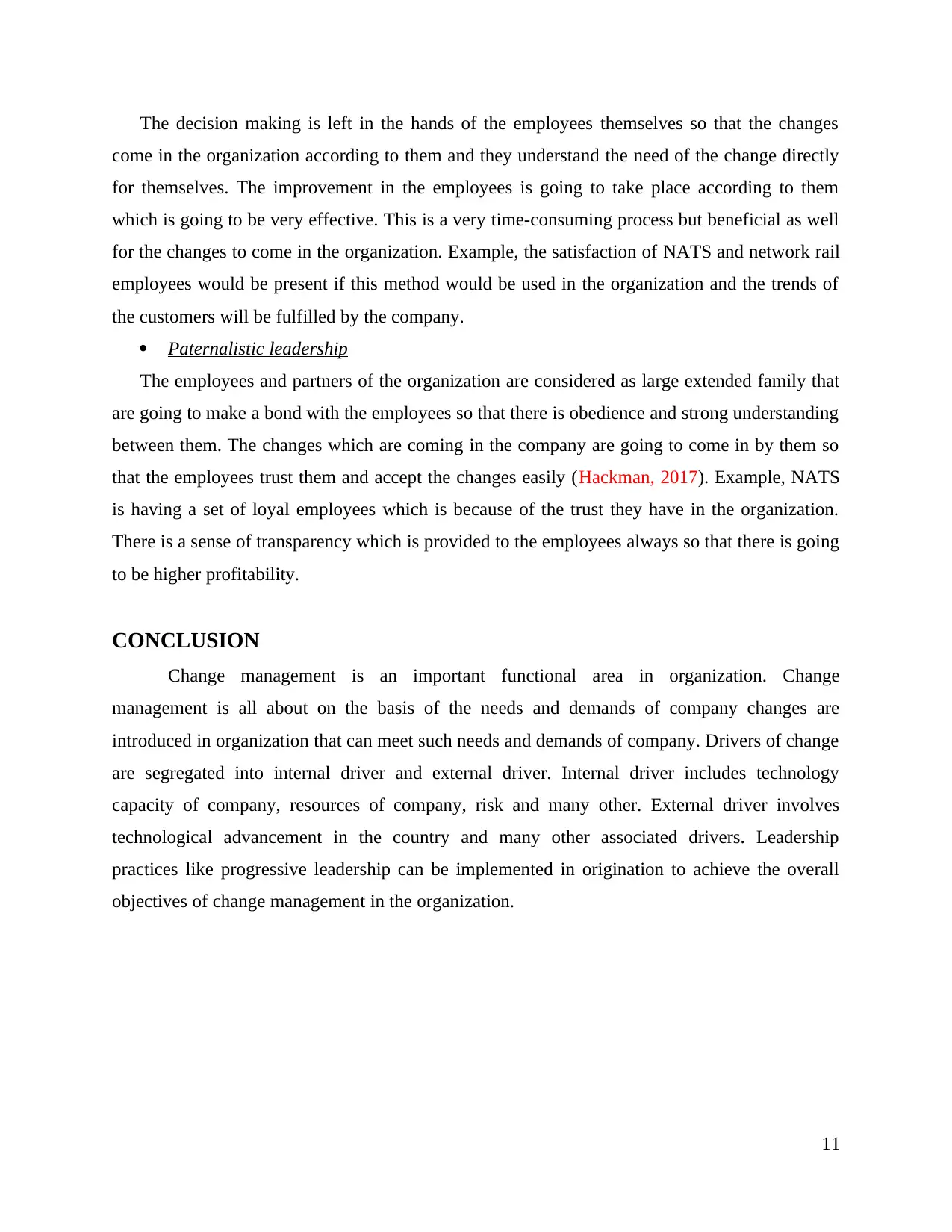
The decision making is left in the hands of the employees themselves so that the changes
come in the organization according to them and they understand the need of the change directly
for themselves. The improvement in the employees is going to take place according to them
which is going to be very effective. This is a very time-consuming process but beneficial as well
for the changes to come in the organization. Example, the satisfaction of NATS and network rail
employees would be present if this method would be used in the organization and the trends of
the customers will be fulfilled by the company.
Paternalistic leadership
The employees and partners of the organization are considered as large extended family that
are going to make a bond with the employees so that there is obedience and strong understanding
between them. The changes which are coming in the company are going to come in by them so
that the employees trust them and accept the changes easily (Hackman, 2017). Example, NATS
is having a set of loyal employees which is because of the trust they have in the organization.
There is a sense of transparency which is provided to the employees always so that there is going
to be higher profitability.
CONCLUSION
Change management is an important functional area in organization. Change
management is all about on the basis of the needs and demands of company changes are
introduced in organization that can meet such needs and demands of company. Drivers of change
are segregated into internal driver and external driver. Internal driver includes technology
capacity of company, resources of company, risk and many other. External driver involves
technological advancement in the country and many other associated drivers. Leadership
practices like progressive leadership can be implemented in origination to achieve the overall
objectives of change management in the organization.
11
come in the organization according to them and they understand the need of the change directly
for themselves. The improvement in the employees is going to take place according to them
which is going to be very effective. This is a very time-consuming process but beneficial as well
for the changes to come in the organization. Example, the satisfaction of NATS and network rail
employees would be present if this method would be used in the organization and the trends of
the customers will be fulfilled by the company.
Paternalistic leadership
The employees and partners of the organization are considered as large extended family that
are going to make a bond with the employees so that there is obedience and strong understanding
between them. The changes which are coming in the company are going to come in by them so
that the employees trust them and accept the changes easily (Hackman, 2017). Example, NATS
is having a set of loyal employees which is because of the trust they have in the organization.
There is a sense of transparency which is provided to the employees always so that there is going
to be higher profitability.
CONCLUSION
Change management is an important functional area in organization. Change
management is all about on the basis of the needs and demands of company changes are
introduced in organization that can meet such needs and demands of company. Drivers of change
are segregated into internal driver and external driver. Internal driver includes technology
capacity of company, resources of company, risk and many other. External driver involves
technological advancement in the country and many other associated drivers. Leadership
practices like progressive leadership can be implemented in origination to achieve the overall
objectives of change management in the organization.
11
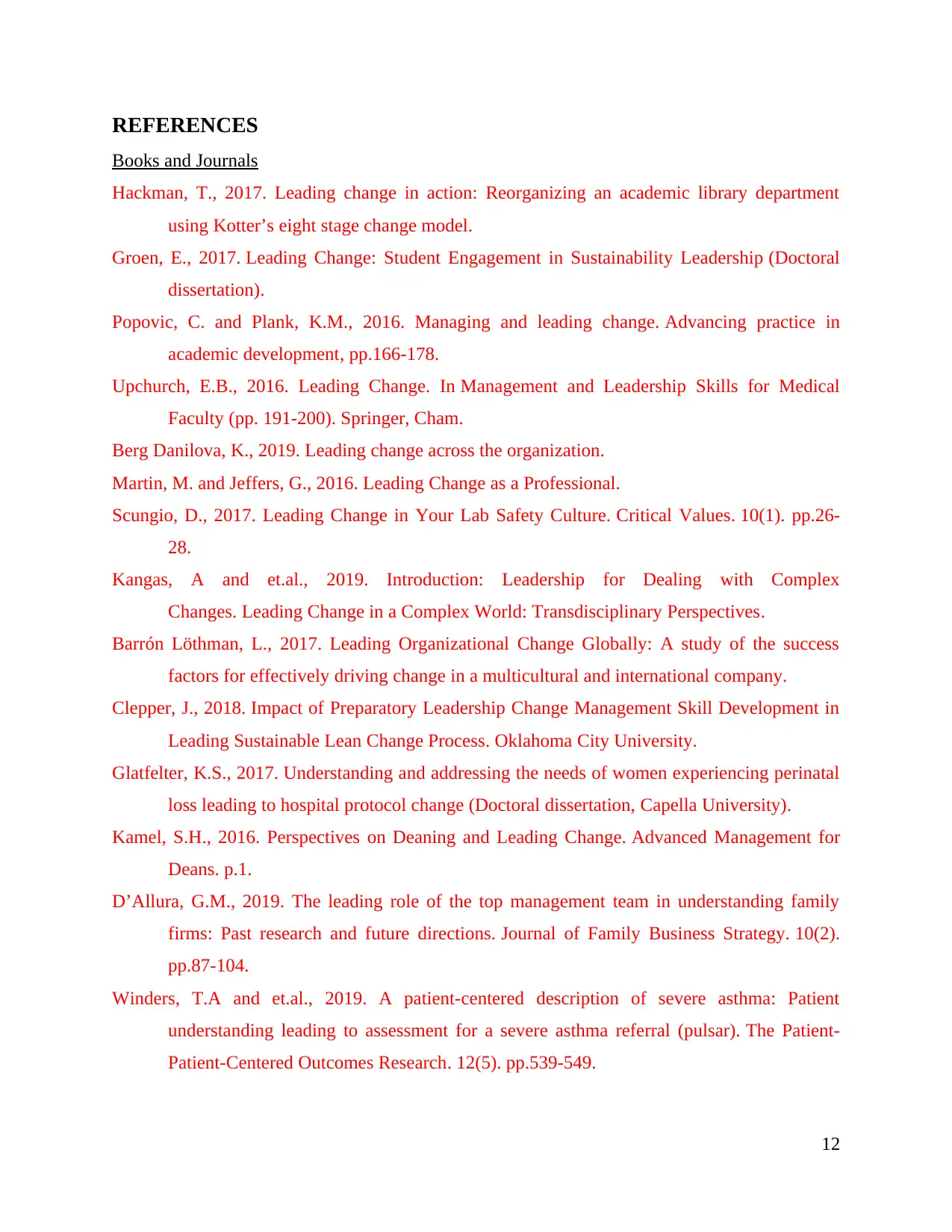
REFERENCES
Books and Journals
Hackman, T., 2017. Leading change in action: Reorganizing an academic library department
using Kotter’s eight stage change model.
Groen, E., 2017. Leading Change: Student Engagement in Sustainability Leadership (Doctoral
dissertation).
Popovic, C. and Plank, K.M., 2016. Managing and leading change. Advancing practice in
academic development, pp.166-178.
Upchurch, E.B., 2016. Leading Change. In Management and Leadership Skills for Medical
Faculty (pp. 191-200). Springer, Cham.
Berg Danilova, K., 2019. Leading change across the organization.
Martin, M. and Jeffers, G., 2016. Leading Change as a Professional.
Scungio, D., 2017. Leading Change in Your Lab Safety Culture. Critical Values. 10(1). pp.26-
28.
Kangas, A and et.al., 2019. Introduction: Leadership for Dealing with Complex
Changes. Leading Change in a Complex World: Transdisciplinary Perspectives.
Barrón Löthman, L., 2017. Leading Organizational Change Globally: A study of the success
factors for effectively driving change in a multicultural and international company.
Clepper, J., 2018. Impact of Preparatory Leadership Change Management Skill Development in
Leading Sustainable Lean Change Process. Oklahoma City University.
Glatfelter, K.S., 2017. Understanding and addressing the needs of women experiencing perinatal
loss leading to hospital protocol change (Doctoral dissertation, Capella University).
Kamel, S.H., 2016. Perspectives on Deaning and Leading Change. Advanced Management for
Deans. p.1.
D’Allura, G.M., 2019. The leading role of the top management team in understanding family
firms: Past research and future directions. Journal of Family Business Strategy. 10(2).
pp.87-104.
Winders, T.A and et.al., 2019. A patient-centered description of severe asthma: Patient
understanding leading to assessment for a severe asthma referral (pulsar). The Patient-
Patient-Centered Outcomes Research. 12(5). pp.539-549.
12
Books and Journals
Hackman, T., 2017. Leading change in action: Reorganizing an academic library department
using Kotter’s eight stage change model.
Groen, E., 2017. Leading Change: Student Engagement in Sustainability Leadership (Doctoral
dissertation).
Popovic, C. and Plank, K.M., 2016. Managing and leading change. Advancing practice in
academic development, pp.166-178.
Upchurch, E.B., 2016. Leading Change. In Management and Leadership Skills for Medical
Faculty (pp. 191-200). Springer, Cham.
Berg Danilova, K., 2019. Leading change across the organization.
Martin, M. and Jeffers, G., 2016. Leading Change as a Professional.
Scungio, D., 2017. Leading Change in Your Lab Safety Culture. Critical Values. 10(1). pp.26-
28.
Kangas, A and et.al., 2019. Introduction: Leadership for Dealing with Complex
Changes. Leading Change in a Complex World: Transdisciplinary Perspectives.
Barrón Löthman, L., 2017. Leading Organizational Change Globally: A study of the success
factors for effectively driving change in a multicultural and international company.
Clepper, J., 2018. Impact of Preparatory Leadership Change Management Skill Development in
Leading Sustainable Lean Change Process. Oklahoma City University.
Glatfelter, K.S., 2017. Understanding and addressing the needs of women experiencing perinatal
loss leading to hospital protocol change (Doctoral dissertation, Capella University).
Kamel, S.H., 2016. Perspectives on Deaning and Leading Change. Advanced Management for
Deans. p.1.
D’Allura, G.M., 2019. The leading role of the top management team in understanding family
firms: Past research and future directions. Journal of Family Business Strategy. 10(2).
pp.87-104.
Winders, T.A and et.al., 2019. A patient-centered description of severe asthma: Patient
understanding leading to assessment for a severe asthma referral (pulsar). The Patient-
Patient-Centered Outcomes Research. 12(5). pp.539-549.
12
⊘ This is a preview!⊘
Do you want full access?
Subscribe today to unlock all pages.

Trusted by 1+ million students worldwide
1 out of 13
Related Documents
Your All-in-One AI-Powered Toolkit for Academic Success.
+13062052269
info@desklib.com
Available 24*7 on WhatsApp / Email
![[object Object]](/_next/static/media/star-bottom.7253800d.svg)
Unlock your academic potential
Copyright © 2020–2025 A2Z Services. All Rights Reserved. Developed and managed by ZUCOL.




